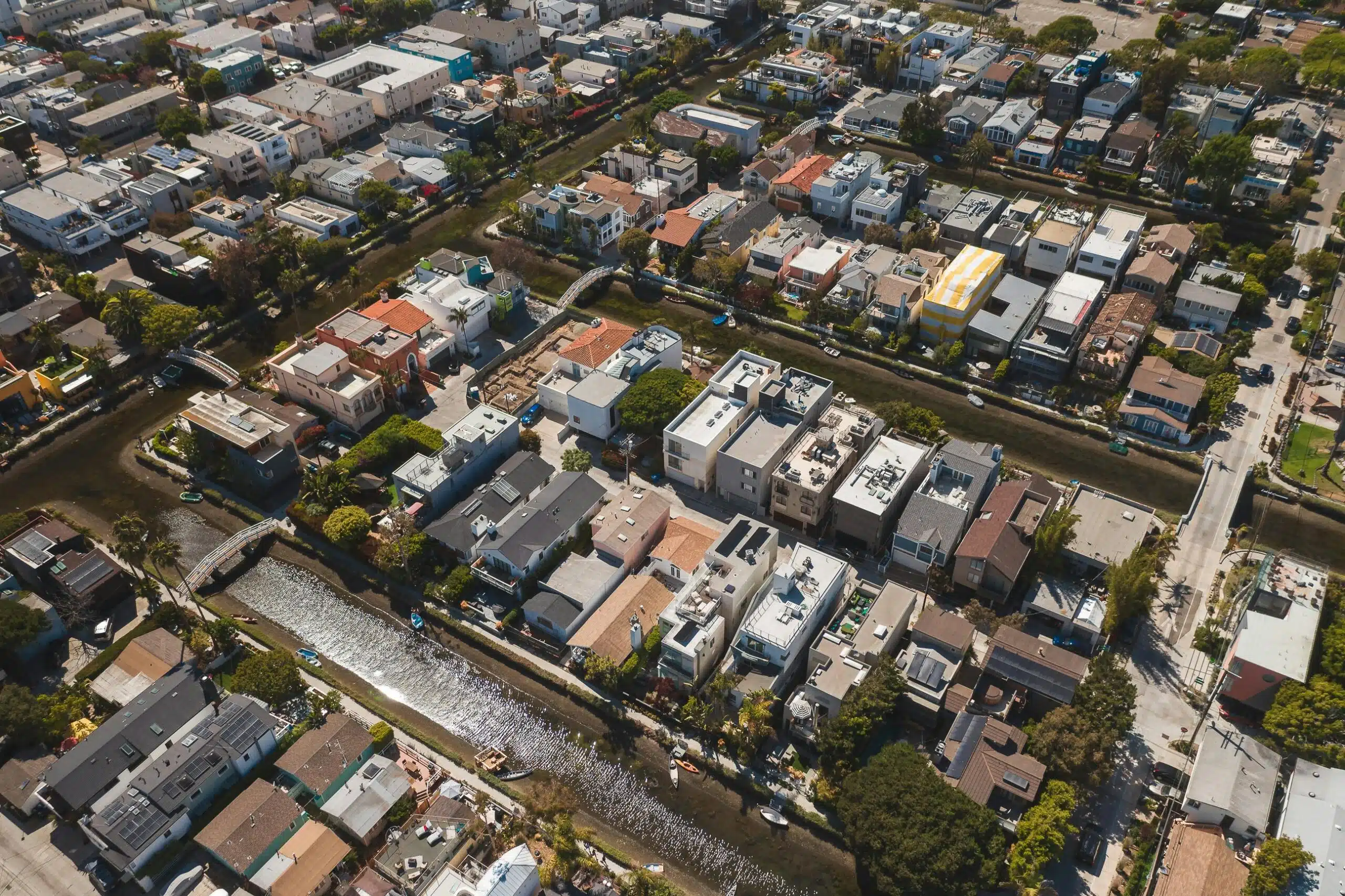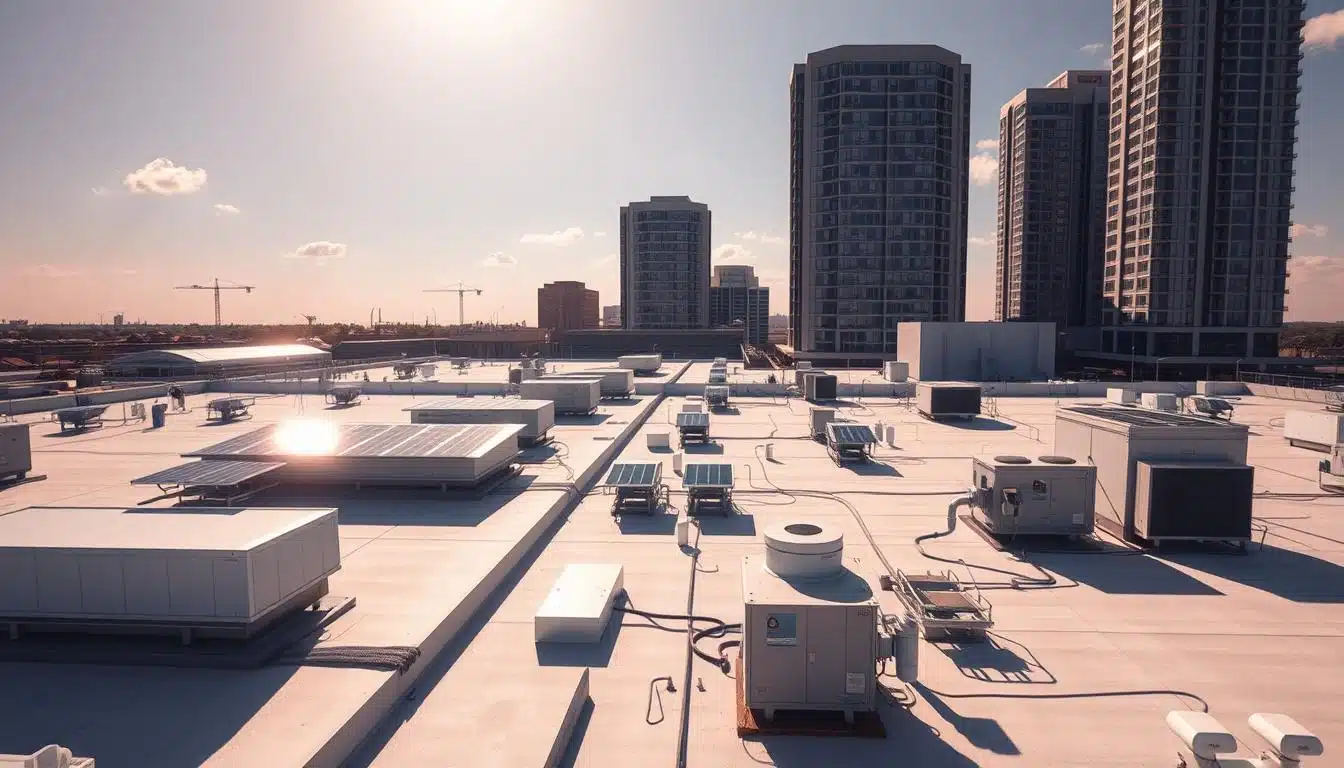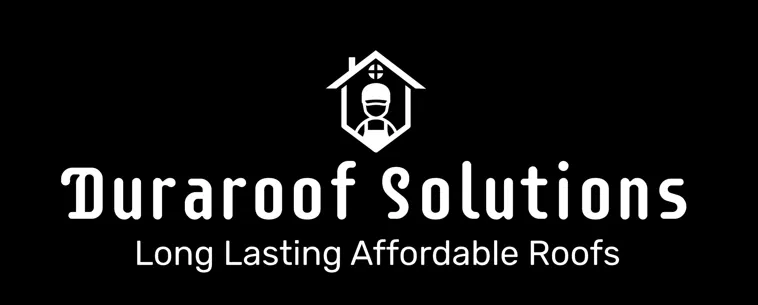When choosing a commercial roofing system, Thermoplastic Polyolefin (TPO) and Polyvinyl Chloride (PVC) are top picks for flat roofs. It’s key to know the differences between TPO and PVC to make the right choice. This article compares these two, looking at durability, cost, energy efficiency, and environmental impact. It aims to help you pick the best option for your commercial roofing needs.
Key Takeaways
- TPO and PVC are two of the most popular thermoplastic flat roofing options for commercial buildings.
- TPO roofing offers excellent resistance to UV rays, ozone, and chemical exposure, while PVC provides superior fire resistance.
- PVC roofing typically costs more than TPO, but it may offer longer-lasting performance and energy efficiency benefits.
- Both TPO and PVC roofing systems can be engineered for high energy efficiency and sustainability, making them attractive options for eco-conscious commercial projects.
- Proper installation by trained professionals is crucial for the long-term performance and durability of both TPO and PVC roofing systems.
Understanding TPO and PVC Roofing Materials
Flat roof systems often use TPO (Thermoplastic Polyolefin) and PVC (Polyvinyl Chloride) roofing. These materials are popular for their energy-saving and durable qualities. They are great for property owners looking for long-lasting roofing solutions.
What is TPO Roofing?
TPO roofing is a single-ply membrane made from polypropylene and ethylene-propylene rubber. It’s known for its strong resistance to UV rays, ozone, and chemicals. This makes TPO a top choice for commercial and industrial roofs.
It also reflects sunlight, helping to keep buildings cooler. This reduces energy costs and fights the urban heat island effect.
What is PVC Roofing?
PVC roofing is a thermoplastic membrane mainly from polyvinyl chloride. It’s known for its durability, fire resistance, and flexibility. PVC is a versatile option for many flat roof systems, including homes and businesses.
PVC can handle harsh weather and prevent mold and mildew. It’s a reliable choice for energy-saving roofing.
Choosing between TPO and PVC depends on the project’s needs, the local climate, and the owner’s preferences. Knowing the benefits of each can help make the right choice. This ensures energy efficiency, long-term performance, and cost-effectiveness.
Durability and Longevity: TPO vs PVC
For commercial property owners, the durability of roofing is key. The lifespan of TPO (Thermoplastic Polyolefin) and PVC (Polyvinyl Chloride) roofs is crucial. This is why they are compared in the roofing membrane comparison.
TPO roofs stand out for their weather and UV resistance. They last 20-30 years, making them a solid choice for commercial roofing materials. Their flexibility and ability to resist tears and punctures are big pluses for flat roofs.
PVC roofs also boast impressive durability and longevity. They can last 25-30 years, similar to TPO. PVC’s strong resistance to chemicals, fire, and environmental stressors makes it a top pick for durable roofing solutions.
| Roofing Membrane | Typical Lifespan | Key Durability Features |
|---|---|---|
| TPO | 20-30 years | Excellent resistance to weathering, UV exposure, and tears |
| PVC | 25-30 years | Robust resistance to chemicals, fire, and environmental stressors |
Both TPO and PVC roofs are known for their durability and long life. The right choice depends on the property’s needs and local climate. It’s all about finding the best fit.
TPO vs PVC Roofing: Cost Considerations
Choosing a flat roof for commercial buildings often starts with the cost. But, it’s smart to look at the total cost over time. The battle between TPO and PVC roofing shows us a lot about costs.
TPO is usually cheaper to start with because it’s easier to install. PVC needs more work and special tools, making it pricier at first.
But, the long-term costs are key. PVC lasts longer and needs less upkeep. TPO might need more fixes and replacements, which could balance out the initial savings.
The cost of running the building also matters. PVC can save on cooling costs because it reflects the sun. TPO absorbs heat, which could raise energy bills. This affects the total cost of owning a commercial property.
| Cost Factor | TPO Roofing | PVC Roofing |
|---|---|---|
| Initial Installation Cost | Lower | Higher |
| Maintenance and Repair Costs | Higher | Lower |
| Energy Efficiency | Lower | Higher |
| Overall Cost of Ownership | Potentially Higher | Potentially Lower |
By looking at the upfront costs, long-term maintenance, and energy efficiency, owners can choose wisely. They aim to find a balance that meets their needs and budget.
Environmental Impact: Eco-Friendly Roofing Solutions
More and more commercial property owners want roofs that are good for the planet. They look for options that protect their buildings and help the environment. TPO (Thermoplastic Polyolefin) and PVC (Polyvinyl Chloride) are top choices because they’re eco-friendly.
Energy Efficiency and Cool Roof Technology
TPO and PVC roofs are great at saving energy. They reflect a lot of sunlight, which means they absorb less heat. This “cool roof” tech can cut down on cooling costs, making buildings more energy-efficient and eco-friendly.
Both TPO and PVC roofs meet or beat tough cool roof standards. This is thanks to groups like the Cool Roof Rating Council (CRRC) and the ENERGY STAR® program. It’s good for the planet and saves money for building owners in the long run.
| Roofing Material | Solar Reflectance Index (SRI) | ENERGY STAR Certification |
|---|---|---|
| TPO Roofing | 78-88 | Yes |
| PVC Roofing | 83-92 | Yes |
Choosing eco-friendly roofing options helps make the world a greener place. It also brings practical benefits like energy-saving cool roof technology and energy-efficient roofing.
“Sustainable roofing solutions not only protect our buildings but also reflect our commitment to the environment.”
Installation and Maintenance: Comparing TPO and PVC
Choosing the right commercial roofing material involves looking at installation and maintenance. TPO and PVC have different needs. Knowing these can help owners and contractors decide.
Professional Installation Requirements
Installing a roof right is key for its long life. TPO and PVC need skilled hands and careful work. TPO might be a bit easier to put on, thanks to its forgiving nature.
But, both need pros to do the job well. The way they’re welded is a big difference. TPO uses hot-air welding, while PVC needs solvent-based welding. This can affect how long it takes and the cost.
| Feature | TPO Roofing | PVC Roofing |
|---|---|---|
| Welding Process | Hot-air welding | Solvent-based welding |
| Ease of Installation | Slightly easier | Requires more expertise |
| Installation Timeline | Generally faster | Can be more time-consuming |
Keeping up with maintenance is vital for both TPO and PVC roofs. Regular checks, fixes, and cleanings are needed. This keeps the roof in good shape and protects the building.
Understanding the needs of TPO and PVC roofs helps make the right choice. It’s about matching the project’s needs and budget.
Weather Resistance and Climate Suitability
Choosing the right roofing for your commercial property is key. Weather resistance and climate suitability are top factors. TPO (Thermoplastic Olefin) and PVC (Polyvinyl Chloride) are top picks for flat roofs. They’re durable and protect against the elements.
Performance in Different Climatic Conditions
TPO and PVC roofing systems handle various weather conditions well. But, their performance can change based on the local climate. Let’s see how they do in different weather:
- Cold and Snowy Climates: TPO and PVC are flexible and strong in cold weather. They can handle snow and ice, reducing leak and damage risks.
- Hot and Humid Environments: Both TPO and PVC resist UV rays and moisture well. They’re good for sunny and humid areas. Their reflective nature also cuts cooling costs.
- Coastal and Saltwater Regions: TPO and PVC resist corrosion and saltwater. They’re a solid choice for coastal buildings.
Investing in TPO or PVC roofing is wise, no matter the climate. It offers lasting protection and peace of mind for building owners.
“Choosing the right roofing system is crucial for ensuring the longevity and resilience of your commercial property, no matter the climate.”
| Climatic Condition | TPO Roofing Performance | PVC Roofing Performance |
|---|---|---|
| Cold and Snowy | Excellent flexibility and resilience | Excellent flexibility and resilience |
| Hot and Humid | Highly resistant to UV rays and moisture | Highly resistant to UV rays and moisture |
| Coastal and Saltwater | Resistant to corrosion and salt-water exposure | Resistant to corrosion and salt-water exposure |
Aesthetic Appeal: Color Options and Customization
Choosing the right commercial roofing material is important. It’s not just about function; it’s also about looks. TPO and PVC roofing systems come in many colors and can be customized. This lets property owners match their roof to their building’s style and their taste.
TPO roofs come in standard colors like white, gray, and tan. These colors are neutral and can make a building look modern and clean. You can also add special pigments or custom designs to TPO roofs. This makes each roof unique and personalized.
PVC roofs, however, offer even more color choices. You can find everything from classic whites and grays to bold colors like blues and reds. This variety lets property owners make a statement or match their roof to their building’s color. PVC roofs can also have patterns or textures added for extra interest.
| Feature | TPO Roofing | PVC Roofing |
|---|---|---|
| Color Options | Neutral tones (white, gray, tan) | Wide range of colors (white, gray, blue, green, red) |
| Customization | Custom pigments, printed patterns | Embossed patterns, textured finishes |
| Visual Impact | Clean, modern aesthetic | Bold design statements, color integration |
When picking a roofing material, think about both function and looks. TPO and PVC offer many color and customization options. This means you can create a roof that looks great and fits your property perfectly.
Commercial vs. Residential Applications
Choosing between TPO and PVC roofing depends on the building’s needs. Commercial and residential roofs have different needs.
Suitability for Different Building Types
Commercial buildings like offices and stores often choose commercial roofing materials. TPO or PVC is great for these big roofs. They last long and handle a lot of wear and tear well.
Residential roofs focus more on looks and ease of installation. While TPO and PVC work, homeowners might also look at asphalt shingles or metal. These fit better with a home’s style.
| Commercial Buildings | Residential Homes |
|---|---|
| Larger, flat roofs | Smaller, sloped roofs |
| Emphasis on durability and weatherproofing | Emphasis on aesthetics and ease of installation |
| Suitability for TPO and PVC roofing | Suitability for asphalt shingles, metal roofing, and select TPO/PVC options |
Choosing TPO or PVC should consider the building’s needs, climate, and future performance.
Warranties and Manufacturer Support
Warranties and manufacturer support are key for commercial property owners. Both TPO and PVC roofing systems offer great warranty coverage. This ensures your investment is protected for a long time.
TPO roofing warranties range from 10 to 30 years. They cover material defects, weathering, and even repair labor costs. PVC roofing warranties last 15 to 30 years. They protect against early wear and tear.
| Roofing System | Warranty Coverage | Manufacturer Support |
|---|---|---|
| TPO | 10-30 years | Extensive network of authorized contractors, technical assistance, and proactive maintenance programs |
| PVC | 15-30 years | Comprehensive training for installers, on-site inspections, and dedicated customer service |
Manufacturer support is a big plus for both durable roofing solutions and commercial roofing materials. TPO and PVC roofing makers have big networks of approved contractors. They offer technical help, training, and maintenance programs for the best performance.
When picking a roofing membrane, think about more than the upfront cost. Look at the warranties and support offered. A roofing system with strong warranties and manufacturer support gives you confidence in your choice.
“The warranty and manufacturer support are crucial elements in ensuring the longevity and reliability of my commercial roofing investment.”
Emerging Trends and Innovations in Flat Roofing
The world of flat roof systems is always changing. New technologies and green solutions are coming up. These changes aim to make roofing more energy-efficient and friendly to the environment. The future of flat roofing looks set for big changes.
Embracing Cool Roof Technology
Cool roof technology is a big deal in flat roofing now. These systems reflect sunlight, which means they absorb less heat. This helps lower energy use and cooling costs.
Advanced coatings and materials make cool roofs popular. They help buildings use less energy and are better for the planet.
Sustainable Roofing Materials
The industry is also moving towards sustainable materials. These include recycled and eco-friendly options. They’re durable and perform well, just like traditional roofs.
These materials cut down on environmental harm. They also save money in the long run by using less energy and lasting longer.
Integrated Solar Solutions
Another trend is adding solar panels to roofs. This lets buildings make their own clean energy. It’s good for the planet and can save money on energy bills.
| Emerging Trend | Key Highlights |
|---|---|
| Cool Roof Technology | Reflective coatings and materials that reduce heat absorption, lowering energy consumption and cooling costs. |
| Sustainable Roofing Materials | Roofing systems with recycled content, bio-based components, and renewable resources for a reduced environmental impact. |
| Integrated Solar Solutions | Seamless integration of photovoltaic panels into the roofing system, enabling on-site renewable energy generation. |
As flat roofing evolves, it’s key for everyone to keep up. Using energy-efficient and green materials can improve roofs. It also helps the planet.
“The future of flat roofing is all about striking a balance between advanced technology, environmental responsibility, and cost-effective solutions.”
Conclusion: Making an Informed Choice
Choosing the right flat roofing material for your commercial property is key. You have to decide between TPO and PVC roofing systems. Each has its own benefits, and the best choice depends on your needs, budget, and environmental goals.
It’s important to look at the durability, energy efficiency, and installation needs of commercial roofing materials. This will help you pick the best flat roof systems for your building. Knowing the differences between TPO and PVC can help you make a smart choice. This choice will protect your building, save money, and look good too.
Whether you choose TPO or PVC, focus on quality, safety, and being green. This will make sure your roof works well and helps your business succeed. Now, you know more about tpo vs pvc roofing and can pick the right one for your needs.
FAQ
What is the difference between TPO and PVC roofing?
TPO and PVC are two common flat roofing materials for commercial buildings. TPO is a single-ply, heat-reflective membrane. PVC, on the other hand, is a more rigid, plastic-based option.
Which option is more durable and long-lasting?
PVC roofing is often seen as more durable and long-lasting than TPO. It withstands weather, UV rays, and chemicals well. This makes it a solid choice for commercial roofs.
How do the installation and maintenance requirements differ between TPO and PVC?
TPO is easier to install and costs less upfront. But, PVC might save money in the long run because it lasts longer and needs less upkeep.
Which option is more energy-efficient and environmentally friendly?
Both TPO and PVC can help save energy, but TPO is more eco-friendly. It reflects more heat and light. PVC, however, may contain harmful chemicals.
How do the cost considerations for TPO and PVC roofing compare?
TPO costs less to install but might cost more to maintain over time. PVC is pricier at first but could be more cost-effective in the long run due to its durability and lower upkeep needs.
What are the key considerations for choosing between TPO and PVC roofing for commercial applications?
When picking between TPO and PVC for commercial roofs, consider durability, energy savings, cost, and environmental impact. Also, think about your building’s climate and needs to choose the best option.





